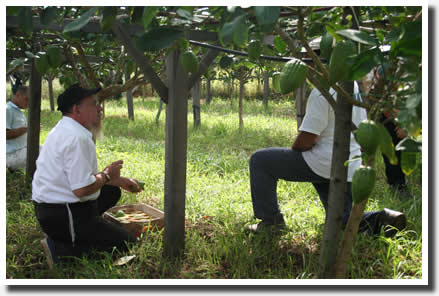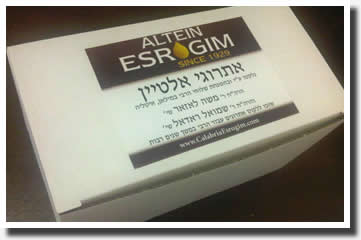Supervision - Hashgacha
 |
| Rabbi Moshe Lazar under the trees |
In a letter of the Rebbe from 1959, in response to an individual who had doubts on the trustworthiness of Rabbi Jacobson, the Rebbe dismisses these doubts, using special terms in regard to Rabbi Jacobson, confirming the Rebbes trust in him. In Hebrew the Rebbe wrote:
והנה ידוע הפסק דין, דעד אחד נאמן באיסורין, ואם אפילו הכרוך בטרחה, אף שבכמה ענינים הנה בתקופתנו דחשך כפול ומכופל, נתערערה חזקה ונאמנות האמורה,
וביודעי ומכירי קאמינא הרב הנ"ל שלמד בהישיבה הק' תומכי תמימים וגם עתה מהמשפיעים תורת החסידות בה, ונאמן בהאמור.
The supervision of the cutting of the Esrogim requires alot of energy and credibility. Here are some examples of what could happen:
Checking the tree
Each tree has to be checked to make sure it was not grafted; this requires much experience, since the grafting could be done in different ways, some of which are hard to detect.
Rabbi Lazar relates that there used to be a field where the workers never brought them to cut Esrogim while many others were cutting, every time the workers gave a different excuse for not being able to go, till one time after much insistance the workers showed them that the trees were grafted and covered with earth.
Supervising the Esrogim
The next step is to make sure that indeed the Esrog that is being cut is from that plant. There have been instances where the farmers took a branch of esrogim from a grafted tree and hung it in between the branches of the genuine tree.
Supervising the field
Two mashghichim are constantly in the field supervising the farmers who are cutting the Esrogim, the third mashgiach goes back and forth to bring the Esrogim to the fourth mashgiach, who packs the Esrogim at the edge of the field.
 In the past, when each field produced a few tens of clean Esrogim, two mashgichim were sufficient. Now, when in each field give hundreds of Esrogim, there is a necessity for more mashgichim.
In the past, when each field produced a few tens of clean Esrogim, two mashgichim were sufficient. Now, when in each field give hundreds of Esrogim, there is a necessity for more mashgichim.
There is also the well-founded possibility, and which has happened many times, that the farmers prepare cases in the field with Esrogim from a grafted tree. If the mashgiach is only sitting at the edge of the field, it might well be that the Esrogim he is receiving are from a grafted tree.
As it is well understood, the farmers can’t be trusted; but the knowledge of the language and the fact that they come from the same country, creates a different relationship between the mashgichim and the farmers. They know these mashgichim cannot be fooled.Supervising the sales
Another important aspect of the Hashgacha is to ensure that the actual Esrogim that were cut with the Hashgocha are the ones that are being sold by the resellers. For this purpose each Esrog box has a special sticker attesting to this.

